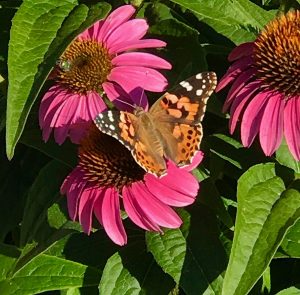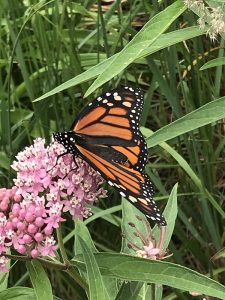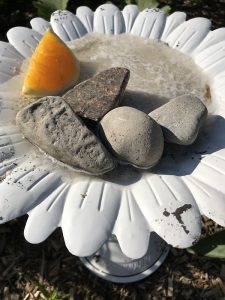In the Garden
Article & Photos By Julianne Labreche
Create a glorious chain reaction in your garden

If a little butterfly magic happens in your garden, celebrate! Just know that it won’t happen overnight. It will happen slowly, gradually, transitioning through different stages — much like the stages of a butterfly’s life. For some gardeners, it may never happen.
For the butterfly, the magic happens this way. A butterfly lays her eggs on a carefully chosen plant in your garden — one that her offspring can feed on. Next comes the larva stage, when those tiny eggs hatch into tiny caterpillars that grow bigger and bigger as they munch the leaves of your plant. Then comes the pupa stage when those fat caterpillars curl up, sleep and develop wings — scientists call this ‘metamorphosis’. Finally — beautiful butterflies emerge, their wings shimmering in the sunlight like tiny bits of translucent stained glass.
For a few gardeners, alas, gardening gloves become weapons of war. Those tiny butterfly eggs get sprayed and destroyed. Those fat caterpillars are picked off and squished. Those sleeping pupa get sucked into some leaf blower or raked into a leaf bag for city composting
No wonder there are so few butterflies these days.
But for any nature-loving gardener — including novices willing to learn — butterfly magic can be just a few steps away. Of course, it may involve a little sweat and some dirty hands but, having created several butterfly gardens since joining Master Gardeners of Ottawa-Carleton, my own logic goes something like this: If a little monarch butterfly can flutter across an entire continent to get to Mexico, then surely this gardener can create a garden oasis to send it on its way.
I really like butterflies, moths, bees, dragonflies and other insects and the birds that add a three dimensional level of interest to my city garden. That’s the magic of creating a butterfly garden.
Turns out, I’m not the only gardener who feels this way. There is a trend in the gardening world these days called ‘wildscaping’ — getting rid of turf grass to create something simpler, more natural. A butterfly garden is sometimes called a ‘meadow cape’ because it consists of swaths of sun-loving meadow flowers and grasses which provide nectar for the butterfly and host plants for the caterpillars.
To be clear, a meadowscape is not a weedscape, a term which describes a mess of weeds that invites Ottawa bylaw officers to come calling if complaints are lodged.
At its best, a meadowscape is a carefully landscaped, tightly planted garden that is a work of beauty both for the creator and the visitors. It also is a relatively risk-free zone for many kinds of butterflies and moths.
To create this, there is work, to be done.
 Butterflies need hot, sunny spaces sheltered from the wind. A suitable location will need to be found. It may involve taking out some turf grass, not so intimidating as it may seem.
Butterflies need hot, sunny spaces sheltered from the wind. A suitable location will need to be found. It may involve taking out some turf grass, not so intimidating as it may seem.
My favourite method for getting rid of lawn is called ‘the lasagna method’, so-called because it’s just like making lasagna but with one crucial difference. Instead of layering pasta, cheese and tomato sauce, you’re layering newspaper or cardboard and then some soil and mulch right on top of the grass. It’s so easy because there’s no sod to dig up and the soil remains undisturbed. This can be done in the fall or early spring.
Then it’s a waiting game. You’ll need to soak it well and wait patiently until the sun bakes that lasagna layered soil while the grass below starts to break down and turn into rich soil. |It’s hard to say how long it will take but digging a test hole through the layers will indicate the state of decomposition.
Meanwhile, it’s a good time to plan which butterfly-friendly plants will go into the meadowscape design.
 Native plants work well because some are host plants for certain butterflies, but some nonnative plants will attract butterflies too. My own front garden is blooming with many plants for monarch butterflies, including red milkweed (Asclepias incarnata) and butterfly weed (Asclepias tuberosa). Both are host plants for monarch butterfly caterpillars. A large bed of black-eyed Susan (Rudbeckia hirta) between my yard and my neighbour’s property plays host for checkerspot butterflies. Ironweed (Vernonia fasciculata) acts as host for painted lady butterflies. Skipper butterflies are attracted to ornamental grasses including big bluestem (Andropogon gerardii), switchgrass (Panicum virgatum) and little bluestem (Schizachyrium scoparium).
Native plants work well because some are host plants for certain butterflies, but some nonnative plants will attract butterflies too. My own front garden is blooming with many plants for monarch butterflies, including red milkweed (Asclepias incarnata) and butterfly weed (Asclepias tuberosa). Both are host plants for monarch butterfly caterpillars. A large bed of black-eyed Susan (Rudbeckia hirta) between my yard and my neighbour’s property plays host for checkerspot butterflies. Ironweed (Vernonia fasciculata) acts as host for painted lady butterflies. Skipper butterflies are attracted to ornamental grasses including big bluestem (Andropogon gerardii), switchgrass (Panicum virgatum) and little bluestem (Schizachyrium scoparium).
Other butterfly-friendly plants, many that grew well in a community butterfly garden that I helped create last summer,include scarlet bee balm (Monarda didyma), blazing star (Liatris), New England aster (Symphyotrichum novaeangliae), Joe-Pye weed (Eutrochium spp.), yarrow (Achillea millefolium), beardtongue (Penstemon digitalis), purple prairie clover (Dalea purpurea), tickseed (Coreopsis), and non-invasive goldenrods such as Solidago ohioensis and Solidago rigida.
There are others, too, as the list of butterfly-friendly plants is long. Typically, butterflies are attracted to purple, pink, yellow and white
flowers.
Butterflies also appreciate a little water among plants. I like to fill a shallow bird bath with sand, rocks and some water so the butterflies can rest, bask their wings in the sun and ‘puddle’ to gather minerals and other nutrients. Setting out some ripened fruit — pieces of peaches, strawberries, nectarines, bananas or oranges — provide valuable nutrients too.
Whatever you decide to grow, a new garden will need some tender loving care until the young plants become established. Regular
watering, weeding and mulching will help. Each year, as their roots become better established and the plants grow stronger, less time will
be needed for their care.
A butterfly garden can be a low-maintenance garden, but it will take a year — maybe two or three — until it becomes fully established. Then, you can sit and watch carefully on some hot summer’s day, and perhaps you will see a lovely monarch, a painted lady or maybe even a black swallowtail flutter by and pause for a moment.
And you will celebrate because, oh joy, the butterflies have arrived! The magic has begun…
Going native
Native seeds are not suited to all soil conditions. Do your research.
Most native perennials need a cold period before they germinate, so native seeds need to be sown in he fall, to experience a natural winter.
Native seeds and plants are available at Seedy Saturday exchanges, some farmers’ markets and the native plant sale held every spring at the Fletcher Wildlife Garden.
Julianne Labreche is a member of the Master Gardeners of Ottawa-Carleton and a freelance writer.






